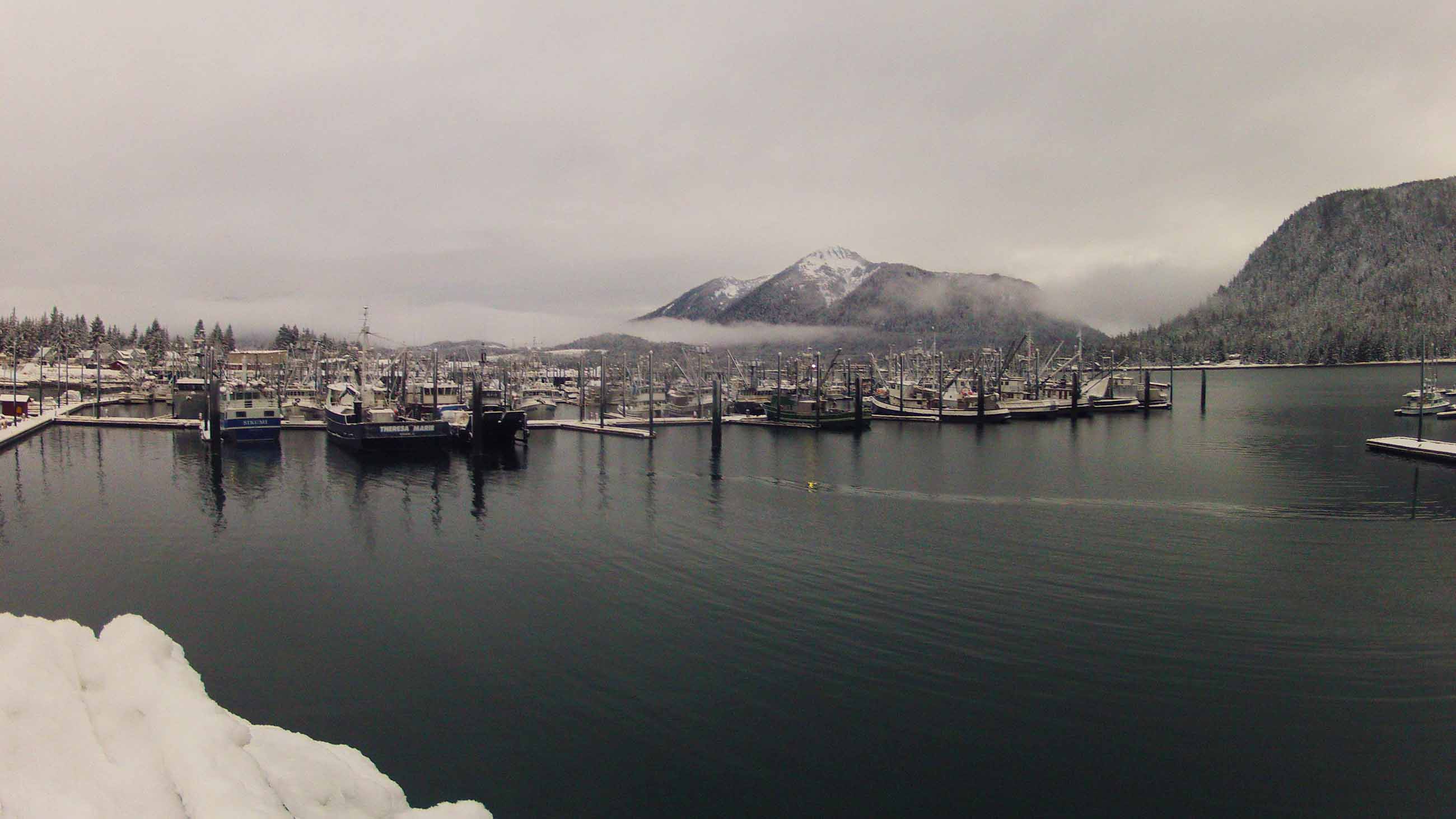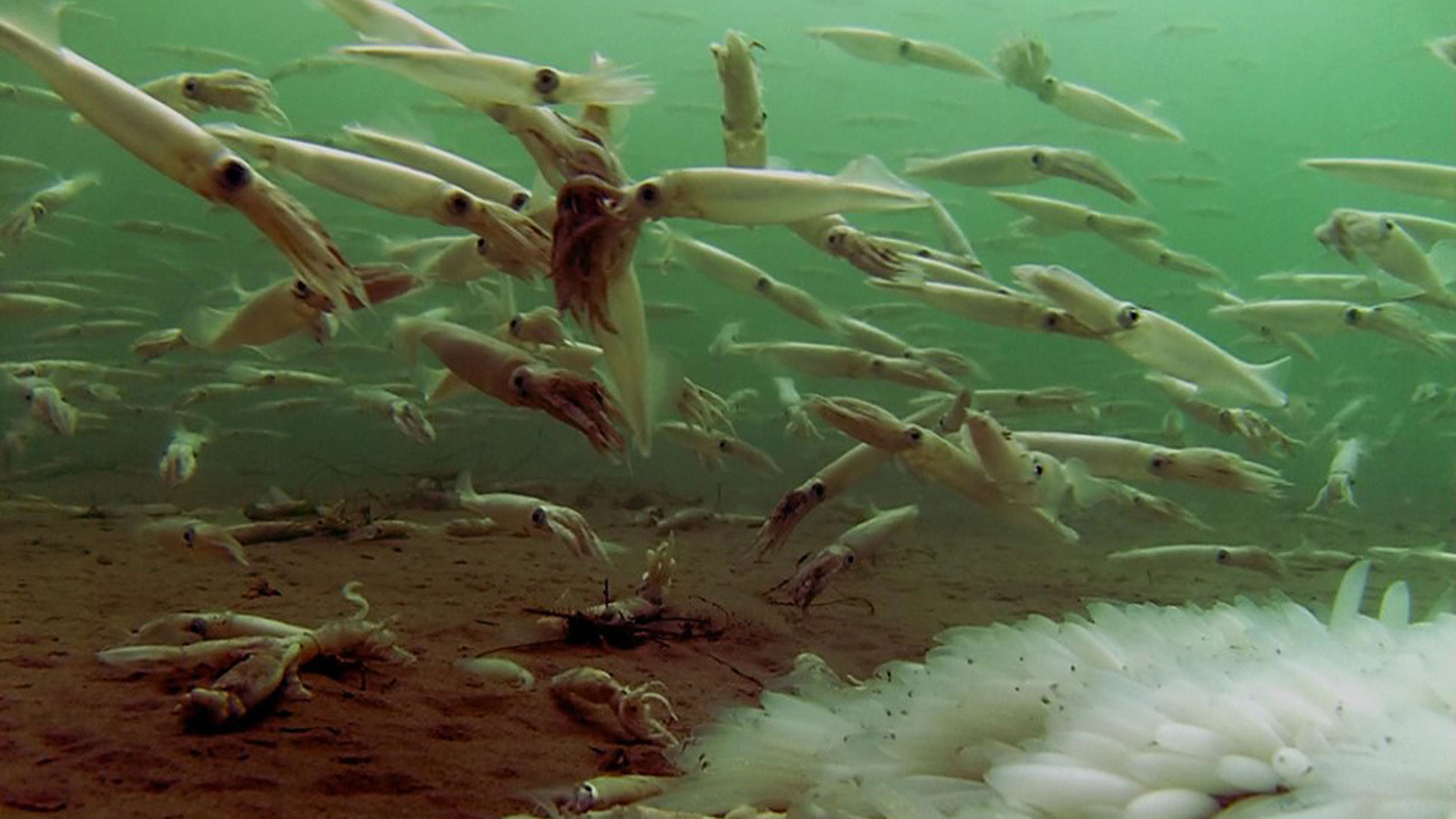As Alaskan Waters Warm, Market Squid Extend Their Reach Northward
Jim Schramek, a retired GIS analyst and hydrologist with the U.S. Forest Service, has been fishing recreationally outside the small Alaskan town of Petersburg for 40 years, but in the last few, things have taken a turn for the worst. Though scientists haven’t yet nailed down the cause, populations of valuable species like king salmon and Pacific grey cod, Schramek says, have fallen to as little as one-tenth of even their 2015 levels. With those populations at historic lows, the Alaska Department of Fish and Game now bans their catch during parts of their historical fishing season.
The bright spot, however, is a small, color-changing squid.
Opalescents, also known as market squid (Doryteuthis opalescens), are showing up in these waters, which were previously considered too cold for them, according to Michael Navarro, an assistant professor of marine fisheries at the University of Alaska Southeast in Juneau. And Schramek and his fellow fishermen are taking note. “I’ve been alongside a [fishing boat] tender the last couple summers when I didn’t have any squid jigging stuff, and they had their boat really lit up,” Schramek says, referring to the luminescent lures used to attract squid. “Lots of lights in the water — just up and down the water column.” While the squid are nowhere near as valuable as king salmon, they’re comparable to the per-pound price of Pacific cod — meaning squid could become a lifeline for fishermen during a time when Earth’s oceans face warming temperatures.
While fish that have traditionally been found in the waters off of Petersburg might struggle to shift northward — particularly salmon, which must breed in rivers that don’t divert easily — “in principle the others can just move with the climate,” says Daniel Pauly, a fisheries expert at the University of British Columbia. In a 2014 article published in the journal Progress in Oceanography — and in many subsequent papers — Pauly and his colleague William Cheung note that a rise of just a fraction of a degree centigrade in ocean temperatures is enough to shift marine habitats north by dozens of miles. The general consensus among climate scientists is that ocean temperatures will rise another degree or more by 2050, exacerbating the habitat changes.
As those climbing temperatures push some marine species northward or wipe them out locally, the new climate also appears to be making waters like those surrounding Mitkof Island, around Petersburg, more hospitable for species that couldn’t handle them before — including market squid.
That would be bittersweet for a town like Petersburg, for which fishing has been a both a mainstay job and pastime for generations, leaving it particularly sensitive to changes in the ocean. The town, with a population just under 3,000, lies about halfway along the 300-mile route from Ketchikan, on Alaska’s southern border, to the capital city of Juneau. Last April, the Alaska Department of Fish and Game issued an emergency order outlawing sport fishing for king salmon in Southeast Alaska for two months. There were hardly enough salmon left here to justify a sport-fishery, the state said, and a similar ban followed in August, closer to the end of the season. The population estimates for 2018 are now the lowest on record.
Cod fishing has fared little better. Just a few weeks back, the commercial Pacific cod fishery in Southeast Alaska was officially shuttered due to a 78 percent decrease in harvest numbers since last year. “I think everybody’s looking for whatever they can,” says Schramek.
Captain Chris Conder of Rum Runner Charters, a sport-fishing operation in Juneau, says that his small tourism company took a substantial hit when the king salmon regulations kicked in last year. The Juneau Charter Boat Operators Association, of which Conder is vice president, suggests that the two-month spring closing of king salmon sport-fishing in 2017 cost Alaska’s capital over half a million dollars in potential revenues.
Market squid isn’t anywhere near as valuable as king salmon, which fetched as much as $7.75 per pound in recent years. But at the 2016-2017 rate of about $.48 per pound in California, market squid is on par with Pacific cod, which was purchased for $.56 per pound prior to bans on commercial fishing for the species in Southeast Alaska. In that sense, market squid could represent an economic lifeline here, and it’s one that Alaskan fishermen are eager to begin experimenting with, given the crash of traditional fisheries.
Justin Peeler, of Sitka, Alaska has fished for market squid off the coast of California for many winters. Recently he received a provisional permit to examine the possibility for a squid fishery here. “The northern range of market squid is likely expanding due to Pacific Ocean warming,” he wrote in his recent proposal to the state to open a squid fishery.
Today, locals in Petersburg are already catching squid for personal use from their boats by jig fishing. These jigs, Schramek says, are “the color of the northern lights. They’re luminescent green. So they have the bioluminescence and you shine a light on ‘em and it charges ‘em up.” The green lights attract squid to the hook when it’s dark. On a recent evening, the moon was a full, flat circle emanating a misty ring — imperfect conditions for squid fishing. “The darker the better,” Schramek says.

According to Navarro, near-shore market squid come close to the coast in large numbers from their feeding grounds to breed. When the squid aggregate, they are easiest to exploit by humans. Navarro completed his Ph.D. in southern California where he studied embryonic development of market squid at Scripps Institution of Oceanography. After completing his dissertation in 2014 he roamed north to Alaska, not unlike the cephalopods. Navarro now studies the basic ecology and embryonic development of market squid in Alaska at his lab. He also goes scuba diving in the ocean to snag the organisms by hand.
“And the reason I’m able to catch them by hand is because by the few days or whatever it takes me to get there, they’ve already spawned a good amount. And so they’re already dying,” Navarro says. Like Pacific salmon, market squid breed just once in their life cycle, and then die.
Navarro says that previously market squid were thought to be restricted to warmer breeding grounds like California, but recent research indicates that they have become successful breeders here, at least since 2015. “Historically, you can find market squid from Vancouver Island, British Columbia down to Baja pretty consistently every year,” says Navarro. Market squid are not unprecedented along Alaska’s south coast, but Navarro suggests the species may well be in the midst of a permanent range change — one that could make their presence here far more common, and permanent.
“I wouldn’t be surprised if a fishery develops in Southeast Alaska,” Navarro says.
That might one day be true, but not yet. On a mid-January afternoon in Petersburg, with 7 inches of snow topping the dock and the rails of vessels in port, the harbor is alive with human foot traffic as the sky darkens from blue to black.
Aboard a boat named Intangible, Peeler, the commercial fisherman, says that the state Board of Fisheries rejected his December proposal for a market squid fishery in these waters. That decision, according to Fish and Game head Scott Kelley, was in part motivated by worries that market squid nets could affect waning king salmon populations. Fishermen are still allowed to hunt for squid with lures and jigs, but salmon and cod fisheries continue to take precedence.
Still, Peeler’s pitch was a landmark, Pauly and Cheung say — suggesting that it might well be the first official fisheries proposal request informed by a habitat shift due to warming seas. Of course, some scientists caution that the market squid migration may be spurred by other factors aside from climate change, and that the shift may not be permanent — the move could simply be part of a periodic migration like those owing to El Niño, says Russ Vetter, a senior scientist at the NOAA Southwest Fisheries Science Center in Southern California. But with average ocean temperatures ticking ever upward, most experts suggest that such habitat shifts — and new fisheries — are inevitable.
When that day comes, both commercial and recreational fishermen appear ready to adapt.
“Those that are 8 to 10 inches — those are the kind that are really good eating,” Schramek says of the squid. “Super tender.”
Theresa Soley is a freelance writer from Wisconsin. She is now based in Juneau, Alaska and has an interest in all things aquatic.











Comments are automatically closed one year after article publication. Archived comments are below.
Everyone says that their commercial fish are moving North. When are you guys going to admit that there has always been the same species in colder waters and now because of the friendlier environment, these species population has exploded – that didn’t happen overnight too. For salmon, more than 20 years ago further North rivers often froze to the bottom in most places, by year 2000 these same streams started having overflows where none used to be before, by 2002 most small streams started having more and more salmon returning to spawn – the Arctic Ecosystems are just friendlier therefore the populations have literally exploded over time; as the further South rivers and streams become too silty and/or warm as a salmon habitat.
I grew up on the very Northern Edge of the Bering Sea, those commercial species that are targeted, yep, we’ve seen them since I was a boy in the early 1960’s. Uhh huhhh, and in the last dozen years or so, they were seeing more and more of those cods. So the halibut, herring, crabs, different cods habitat will be so good, those Southern fishermen will want this new fishery to themselves, it is really the NW Alaska Coastal villages that need to benefit from this new fishery in this day and age.
Now I want to give then another try!
Always found them too rubbery.
Loved this article!